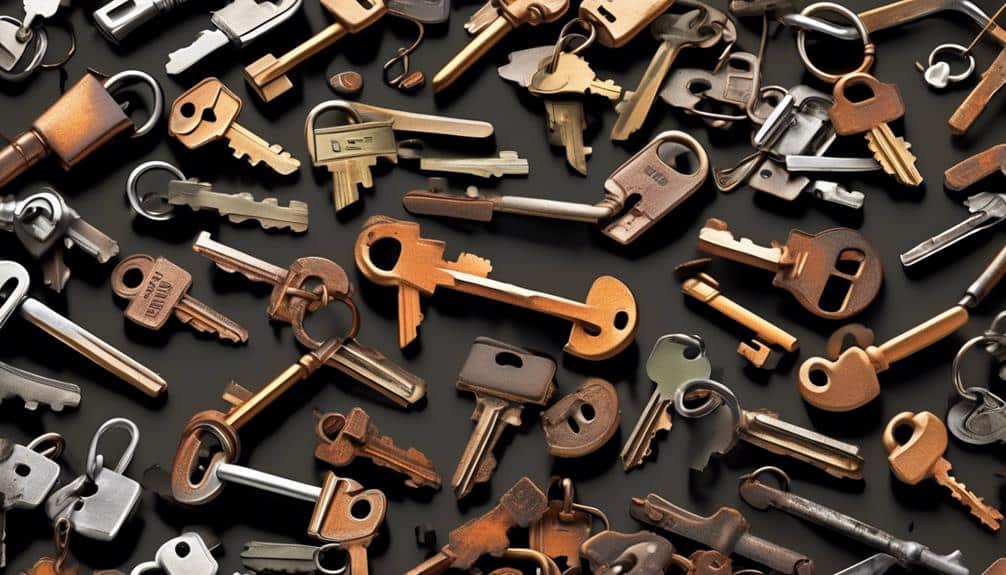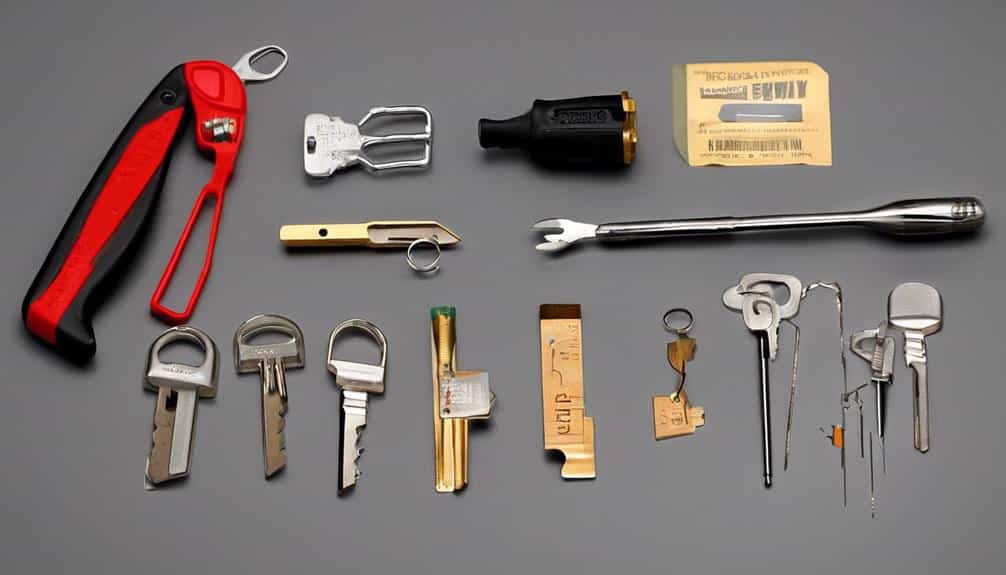Did you know that approximately 20% of key-related lock issues stem from broken keys? It's a frustrating situation that many of us have encountered at least once.
But fear not, because we're here to share some effective tips on how to repair broken keys on locks. From common causes to essential tools and step-by-step techniques, we'll guide you through the process of key extraction and restoration.
Plus, we'll even provide some prevention and maintenance tips to help you avoid key breakage in the future.
So, if you're tired of being locked out or dealing with finicky locks, stick around because we've got you covered.
Common Causes of Broken Keys

One of the most common causes of broken keys is excessive force applied while turning the key in the lock. This can happen when a person is in a hurry or when the lock is sticky or difficult to turn. When too much force is applied, the key may snap or break, leaving a portion of it stuck in the lock.
Another cause of key breakage is using a key that's worn out or damaged. Over time, keys can become worn down or bent, making them more prone to breaking. It's important to regularly inspect and replace keys that show signs of wear and tear to prevent breakage.
Improper key insertion can also lead to key breakage. Inserting the key at an angle or not fully inserting it into the lock can cause it to snap. It's important to insert the key straight into the lock and ensure it's fully inserted before turning.
To fix a broken key, there are a few options available. If a portion of the key is still sticking out, gently pull it out with pliers. If the key is completely stuck in the lock, lubricating the lock with WD-40 or graphite powder may help loosen it. If these methods fail, it may be necessary to call a professional locksmith for assistance.
Essential Tools for Key Repair

After understanding the common causes of broken keys, it's important to have the essential tools for key repair to effectively address the issue.
When it comes to key repair techniques, having the right tools can make all the difference. One essential tool is a key extractor. This tool is specifically designed to remove broken keys from locks without causing any further damage. Key extractors come in various shapes and sizes, allowing you to choose the one that best fits the type of lock you're working on.
Another important tool is a broken key removal kit. This kit usually includes a set of specialized tools that help you remove broken keys from locks. These tools typically include tweezers, hooks, and probes, which enable you to carefully extract the broken key parts and restore the functionality of the lock.
Additionally, having a set of precision screwdrivers is essential for key repair. These screwdrivers allow you to disassemble the lock and access the broken key parts, making it easier to remove and repair them.
With the right key repair tools at your disposal, you can confidently tackle broken keys and restore the functionality of locks efficiently.
Step-by-Step Key Extraction Process

To successfully extract a broken key from a lock, it's crucial to follow a step-by-step process that ensures the safe and efficient removal of the key without causing any further damage. Key extraction techniques can vary depending on the type of lock and the severity of the breakage. In some cases, it may be possible to extract the key using household tools, while in more complex situations, it's advisable to seek professional locksmith services.
The first step in the key extraction process is to assess the situation and determine the cause of the breakage. This involves examining the lock and identifying any visible signs of damage or misalignment. Once the cause has been determined, the next step is to gather the necessary tools for extraction. These tools may include needle-nose pliers, tweezers, or a broken key extractor tool.
After gathering the tools, it's important to lubricate the lock. This can be done by spraying a small amount of graphite lubricant or WD-40 into the keyhole. The lubricant helps to reduce friction and makes it easier to remove the broken key.
With the lock lubricated, the next step is to carefully insert the extraction tool into the keyhole. The tool should be inserted as far as possible, ensuring that it gets a firm grip on the broken key. Once the tool is securely in place, gentle twisting and pulling motions can be applied to extract the key. It's important to be patient and avoid applying excessive force, as this can cause further damage to the lock.
If the key extraction process proves to be challenging or unsuccessful, it's recommended to seek professional locksmith services. Professional locksmiths have specialized tools and expertise to safely and efficiently extract broken keys without causing any damage to the lock. They can also provide additional services such as lock repair or replacement if necessary.
Techniques for Key Restoration

Using specialized techniques, key restoration involves repairing broken or damaged keys to restore their functionality and ensure a proper fit within the lock. When it comes to key restoration, there are various methods and services available to help fix broken keys and bring them back to working condition. Here are some key duplication methods and key repair services that can be utilized:
| Key Duplication Methods | Key Repair Services |
|---|---|
| Traditional key cutting | Key reshaping and filing |
| Laser key cutting | Broken key extraction |
| Key cloning | Key rekeying |
Traditional key cutting is a common method used to duplicate keys, where a machine cuts a new key based on the original. Laser key cutting, on the other hand, uses a laser to precisely cut the key, providing a more accurate duplication. Key cloning involves creating an exact copy of the original key using specialized equipment.
When it comes to key repair services, key reshaping and filing can fix minor issues such as bent or misshapen keys. Broken key extraction is a technique used to remove broken pieces of a key from the lock. Key rekeying involves changing the internal components of the lock to match a new key, providing a solution when the original key is irreparable.
Prevention and Maintenance Tips for Avoiding Key Breakage

In order to prevent key breakage and maintain the functionality of your keys, it's important to follow certain prevention and maintenance tips.
One key aspect of preventing key breakage is proper key lubrication techniques. Regularly lubricating your keys can help reduce friction and wear, which can lead to breakage. To lubricate your keys, you can use a graphite-based lubricant or a silicone spray. Apply a small amount of lubricant to the key, then insert and remove it from the lock several times to distribute the lubricant evenly.
Additionally, choosing the right key material is crucial for avoiding breakage. Opt for keys made of durable materials such as brass or nickel silver, as they're less prone to bending or breaking. Avoid using keys made of weak materials like aluminum or plastic.
It's also important to avoid putting excessive pressure on your keys when turning them in the lock. Gentle and steady pressure is enough to open the lock, preventing unnecessary stress on the key.
Frequently Asked Questions
Can Broken Keys Be Repaired Without Professional Help?
Yes, broken keys can often be repaired without professional help.
When it comes to repairing broken keys at home, there are effective tips that can help you successfully fix them.
However, it's important to be cautious and avoid common mistakes while fixing broken keys.
How Long Does It Take to Extract a Broken Key From a Lock?
Extracting a broken key from a lock can vary in time depending on the complexity of the situation. Common causes of broken keys in locks include excessive force, worn-out keys, or foreign objects obstructing the lock.
To effectively extract a broken key, methods such as using needle-nose pliers, lubricants, or a broken key extractor tool can be employed. These methods are known for their efficiency and precision in removing broken keys from locks.
Can I Use Household Items as Tools for Key Repair?
Using household items for key repair can be a risky endeavor. While it may seem convenient, it's important to prioritize safety when dealing with broken keys and locks.
Instead, rely on proper tools and techniques to safely remove a broken key from a lock. This ensures that you don't cause further damage or compromise the security of your lock.
Are There Any Specific Techniques to Restore Antique or Delicate Keys?
Restoring antique keys and repairing delicate keys require specific techniques to ensure their preservation.
With antique keys, it's crucial to handle them with care and avoid using harsh chemicals or excessive force.
Delicate keys may need gentle straightening or lubrication.
It's best to consult a professional locksmith or restoration expert for these types of keys, as they have the expertise and tools needed to perform the repairs effectively and safely.
What Should I Do if My Key Breaks off Inside a Lock While It's Unlocked?
If our key happens to break off inside a lock while it's unlocked, it can be quite the predicament. However, fear not! We can share some helpful tips on how to handle this unfortunate situation.
Firstly, to prevent keys from breaking in locks, make sure to use gentle pressure when turning the key.
If a key does break off inside a locked door, we should avoid trying to extract it ourselves, as this may cause further damage. Instead, it's best to seek the assistance of a professional locksmith to safely remove the broken key.

